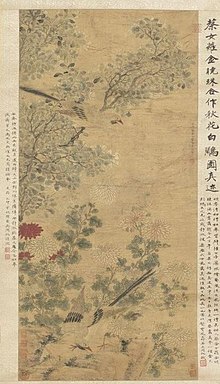Bird-and-flower painting
| Bird-and-flower painting | |||||||
|---|---|---|---|---|---|---|---|
 Early Autumn, 13th century, perhaps by the Song loyalist painter Qian Xuan. The decaying lotus leaves and dragonflies hovering over stagnant water are likely a veiled criticism of Mongol rule.[1] | |||||||
| Chinese name | |||||||
| Traditional Chinese | 花鳥畫 | ||||||
| Simplified Chinese | 花鸟画 | ||||||
| |||||||
| Vietnamese name | |||||||
| Vietnamese alphabet | Hoa điểu hoạ | ||||||
| Chữ Hán | 花鳥畫 | ||||||
| Korean name | |||||||
| Hangul | 화조화 | ||||||
| Hanja | 花鳥畵 | ||||||
| |||||||
| Japanese name | |||||||
| Kanji | 花鳥画 | ||||||
| |||||||
Bird-and-flower painting, called Huaniaohua (simplified Chinese: 花鸟画; traditional Chinese: 花鳥畫; pinyin: huāniǎohuà) in Chinese, is a kind of Chinese painting with a long tradition in China and is considered one of the treasures of Chinese culture.[2] The huaniaohua was named after its subject matter. It originated in the Tang dynasty where it gained popularity, matured by the end of that period and during the Five Dynasties and Ten Kingdoms period,[3] and fully reached its peak during the Song dynasty.[2][4] Most huaniaohua paintings belong to the scholar-artist style of Chinese painting. In the coming centuries, the genre gained popularity and spread throughout the East Asian cultural sphere. It also had an influence on Iranian painting in the golomorgh genre of illustration for book covers and illuminated manuscripts.
Intended purpose and cultural significance
[edit]According to Chinese tradition, the huaniaohua covers "flowers, birds, fish, and insects" (simplified Chinese: 花鸟鱼虫; traditional Chinese: 花鳥魚蟲; pinyin: huāniǎoyúchóng); thus, it can deal with a wide range of natural topics, including flowers, fish, insects, birds, pets (dogs, cats), etc.
The huaniaohua paintings are inspired by the resilience and the beauty of the flowers and birds found in nature.[4] The intended purpose of the huaniaohua was not simply imitate nature, but to use different painting styles to convey the personality and ideas of the artist.[2] In Chinese culture, different types of birds and flowers held their own symbolic meanings;[2] with some of them even holdings auspicious meanings, scholarly and human virtues, as well as principles.[4]
Scholars-artists, in particular, developed a freehand-style painting as a mean to express their emotions and considered Chinese calligraphy and poetry as being an integral component of their huaniaohua painting by giving their ares with a deeper spiritual meaning.[2]
Schools and great artists
[edit]
The huaniaohua is proper of 10th century China; and the most representative artists of this period are Huang Quan (哳㥳) (c. 900 – 965), who was an imperial painter for many years, and Xu Xi (徐熙) (937–975), who came from a prominent family but had never entered into officialdom.[5]: 17 Both Huang Quan and Xu Xi were masters of their two schools.
The first school, led by Huang Quan, was characterized by an "outline" method of brush work, with emphasis on bright colours filling a meticulously outline (gongbi).[6] Huang Quan used to paint based on exotic flowers, herbs, rare birds and animals which were found in the imperial gardens and palaces; his paintings were characterized by their meticulous nature as well as the bright colours.[5]: 17 Huang Quan's painting style was thus acclaimed as Huangjiafugui (lit. 'The Huang school's characteristic magnificience').[5]: 17
The second school was led by Xu Xi whose paintings style became known as Xu Xi yeyi (lit. 'Xu Xi's unconventional', ' original charm').[5]: 17 His school was typically characterized with the use techniques associated with ink wash painting (Chinese: 水墨画).[6]
These two schools would have important influences on huaniaohua paintings of the later centuries.[5]: 17
Varieties based on painting technique
[edit]According to painting technique:
- Ink wash painting (水墨花鳥/水墨花鳥畫). Representatives: Lin Liang (林良), Qi Baishi (齊白石), Zhang Daqian (張大千)
- Gongbi or fine-brush huaniao (工筆花鳥/工筆花鳥畫)
- Xieyi or freehand style (寫意花鳥/寫意花鳥畫)
- Gongbi with xieyi(兼工帶寫)
In Japan
[edit]
Bird-and-flower painting was introduced to Japan during the 14th century, and then to Korea. The bird-and-flower motif started appearing in Japanese art around the Muromachi period during the 14th century, and developed its own distinct style. It also entered ukiyo-e woodblock printing, where it was known as kachō-e (花鳥絵). Especially the shin hanga movement produced a number of works with this motif starting in the Meiji era. Artists working with this were Ohara Koson (1877–1945) and Ito Sozan (1884–?), as well as Imao Keinen (1845–1924).[7][8]
See also
[edit]Gallery
[edit]- Huaniaohua of China
References
[edit]- ^ "Early Autumn (29.1)". Detroit Institute of Arts. Archived from the original on 2008-10-02. Retrieved 2008-12-18.
- ^ a b c d e "Nature's Song: Chinese Bird and Flower Paintings". Museum Wales. Archived from the original on 2022-08-04. Retrieved 2022-08-04.
- ^ "Flower-and-Bird Paintings". en.chinaculture.org. Retrieved 2022-08-04.
- ^ a b c "Contemplating Nature: Chinese and Korean Bird-and-Flower Paintings". eaa.fas.harvard.edu. Retrieved 2022-08-04.
- ^ a b c d e Flower-and-bird painting in ancient China. Xiangping Li, Da Shao, 李向平., 邵达. (Di 1 ban ed.). Beijing: China International Press. 2007. ISBN 978-7-5085-1128-3. OCLC 313467014.
{{cite book}}: CS1 maint: others (link) - ^ a b Marco, Meccarelli. 2015. "Chinese Painters in Nagasaki: Style and Artistic Contaminatio during the Tokugawa Period (1603–1868)" Ming Qing Studies 2015, Pages 175–236.
- ^ "hanga gallery . . . torii gallery: Bird and Flower Prints". www.hanga.com. Archived from the original on 2017-02-04. Retrieved 2017-04-11.
- ^ "Keinen kacho gafu 景年花鳥画譜 (Album of Bird-and-Flower Pictures by Keinen)". British Museum.
External links
[edit]![]() Media related to Bird-and-flower paintings at Wikimedia Commons
Media related to Bird-and-flower paintings at Wikimedia Commons
- Chinese Flower Painting at China Online Museum
- Chinese Bird Painting at China Online Museum





